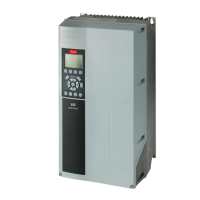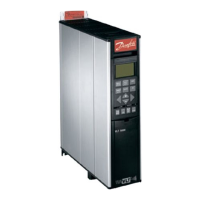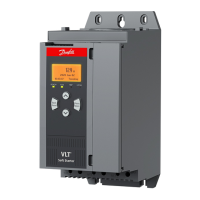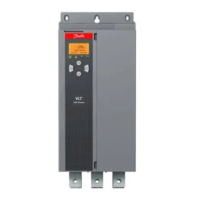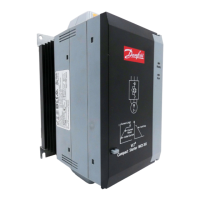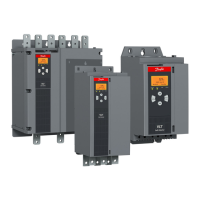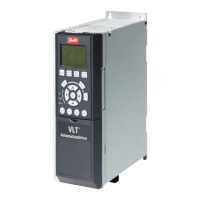Synchronizing controller
MG.10.N4.02 - VLT is a registered Danfoss trademark 55
Velocity feed forward can also be optimized manually by the following procedure:
1. Set parameter 706 PID bandwidth to “0”.
2. Set parameter 719 maximum track error to a high value (e.g. 1.000.000).
3. Set parameter 707 velocity feed forward to 100.
4. Start test-run with virtual master with a known velocity via input 3 = 1.
5. Increase parameter 707 while watching master and slave velocity (press
[DISPLAY/STATUS] to get the velocity readouts). You have found the optimal velocity
feed forward when slave velocity is approximately equal to the master velocity.
6. Stop test-run by input 3 = 0.
7. Reset parameter 719 to the original value.
8. Reset parameter 706 to 1000.
Second step is to optimise the PID controller, a good starting point can be found be means of
the automatic calculation function:
By setting parameter 729 to “2” velocity feed forward calculation is activated as well as
calculation of PID sample time and P/D factors, remember to make the required parameter
settings according to the description of par. 729 before starting the calculation. The
calculation is done when the value of par. 729 returns to “0”.
Using the test run functions can optimise the PID factors further:
There is two types of test run available: Positioning where the slave drive moves a specific
distance and Synchronizing with virtual master where the slave follows the virtual master in
position or speed. Generally it is better to use test run with virtual master as that comes
closer to the operating conditions in synchronizing mode (program 2).
For test run with positioning the following parameters must be set:
Parameter 725 Test run speed: Record the speed as a percentage of the maximum speed
of parameter 716.
Parameter 726 Test run acceleration: record the acceleration time in per cent. 100% is
minimum acceleration. 50% is half as fast as minimum acceleration, the
ramp time will thus be twice as long.
Parameter 727 Test run distance: Record the distance (quad counts) for the drive to run
during optimization.
Then use the following procedure:
1. Close the contacts at terminal 32 (clockwise direction) or terminal 33 (counter-clockwise). During
the test the last value of the first display line will indicate the track error (PID error). After the test
run is completed you can see the maximum track error (PID error).
2. Increase the P-portion (par. 702). After each change you should make a test run to find the right
setting. If the drive becomes unsteady or if a message is given about over-voltage or over-
current, then reduce the value in parameter 702 to about 70-80% of the set value.
3. Now set the D-portion (parameter 703) to 5 times the value of parameter 702.
4. If a lower synchronizing error is required the I-portion (parameter 704) can be set to a low
value e.g. 10 but be careful a too high value will course overshoot and instability
For test run with virtual master the following parameters must be set:
Parameter 748 Virtual master reference: Select the reference source for setting the velocity
of the virtual master. “0” is analogue input 53, “1” is analogue input 60, “2”
is parameter 216 and “3” is Field bus PCD 2.
Parameter 749 Virtual master acceleration: Set the acceleration of the virtual master in
encoder pulses per second
2
.
Parameter 750 Virtual master maximum speed: Set the maximum velocity of the virtual
master in encoder pulses per second.
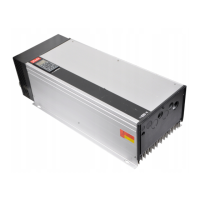
